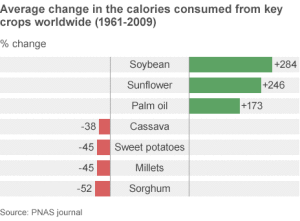Crop Diversity Decline ‘Threatens Food Security’
ENVIRONMENT, 10 Mar 2014
Fewer crop species are feeding the world than 50 years ago – raising concerns about the resilience of the global food system, a study has shown.
The authors warned a loss of diversity meant more people were dependent on key crops, leaving them more exposed to harvest failures.
Higher consumption of energy-dense crops could also contribute to a global rise in heart disease and diabetes, they added.
The study appears in the journal PNAS.
“Over the past 50 years, we are seeing that diets around the world are changing and they are becoming more similar – what we call the ‘globalised diet’,” co-author Colin Khoury, a scientist from the Colombia-based International Center for Tropical Agriculture, explained.
“This diet is composed of big, major cops such as wheat, rice, potatoes and sugar.
“It also includes crops that were not important 50 years ago but have become very important now, particularly oil crops like soybean,” he told BBC News.
While wheat has long been a staple crop, it is now a key food in more than 97% of countries listed in UN data, the study showed.
And from relative obscurity, soybean had become “significant” in the diets of almost three-quarters of nations.
He added that while these food crops played a major role in tackling global hunger, the decline in crop diversity in the globalised diet limited the ability to supplement the energy-dense part of the diet with nutrient-rich foods.
Amid the crops recording a decline in recent decades were millets, rye, yams, sweet potatoes and cassava.
The study by an international team of scientists also found that the homogenisation of the global diet could be helping accelerate the rise in non-communicable diseases – such as diabetes and heart disease – which are becoming an increasing problem worldwide.
Crop failure fears
Fellow co-author Luigi Guarino, from the Global Crop Diversity Trust, added: “Another danger of a more homogeneous global food basket is that it makes agriculture more vulnerable to major threats like drought, insect pests and diseases, which are likely to become worse in many parts of the world as a result of climate change.
‘Doomsday vault’

The Svalbard Global Seed Vault is designed to protect the genetic diversity of the world’s food crops.
“As the global population rises and the pressure increases on our global food system, so does our dependence on the global crops and production system that feeds us.
“The price of failure of any of these crops will become very high,” he warned.
Last month, the European Parliament adopted a resolution that called on EU nations to adopt measures to preserve crops’ biological and genetic diversity in order for plant breeders to provide adaptable varieties of crops that will be able to cope with projected climatic changes and the need to increase yields.
MEPs said they were concerned that the global plant breeding market was currently “dominated by just a few large multinational undertakings which invest only in a limited number of varieties”.
They added that estimates from the UN Food and Agriculture Organization (FAO) suggested that “the diversity of cultivated crops declined by 75% during the 20th Century and a third of of today’s diversity could disappear by 2050”.
Another study published in February warned there was a risk that the severity of some wheat disease epidemics may increase within the coming decades as a result of the impacts of climate change.
In order to improve the resilience of the global food system to future shocks, Mr Khoury said an expansion in the diversity of the globally important crops was needed.
“We also need to ensure the the genetic diversity is available to people,” he suggested.
“That diversity comes from old varieties and the wild species that are related to the crops.
“A good example is if you are a breeder of maize (corn) in southern Africa where the crop is the main staple, then the diversity you will want will typically come from where the crop originated, which is Mesoamerica (Mexico to Belize).
“It is important already and will be increasingly important in the future that the people producing varieties suitable for southern Africa actually have access to varieties from Mexico.”
Related Stories
- Key crops head to ‘doomsday vault’
- Uncertainty hampering food security
- Climate ‘drives crop pest spread’
DISCLAIMER: The statements, views and opinions expressed in pieces republished here are solely those of the authors and do not necessarily represent those of TMS. In accordance with title 17 U.S.C. section 107, this material is distributed without profit to those who have expressed a prior interest in receiving the included information for research and educational purposes. TMS has no affiliation whatsoever with the originator of this article nor is TMS endorsed or sponsored by the originator. “GO TO ORIGINAL” links are provided as a convenience to our readers and allow for verification of authenticity. However, as originating pages are often updated by their originating host sites, the versions posted may not match the versions our readers view when clicking the “GO TO ORIGINAL” links. This site contains copyrighted material the use of which has not always been specifically authorized by the copyright owner. We are making such material available in our efforts to advance understanding of environmental, political, human rights, economic, democracy, scientific, and social justice issues, etc. We believe this constitutes a ‘fair use’ of any such copyrighted material as provided for in section 107 of the US Copyright Law. In accordance with Title 17 U.S.C. Section 107, the material on this site is distributed without profit to those who have expressed a prior interest in receiving the included information for research and educational purposes. For more information go to: http://www.law.cornell.edu/uscode/17/107.shtml. If you wish to use copyrighted material from this site for purposes of your own that go beyond ‘fair use’, you must obtain permission from the copyright owner.
